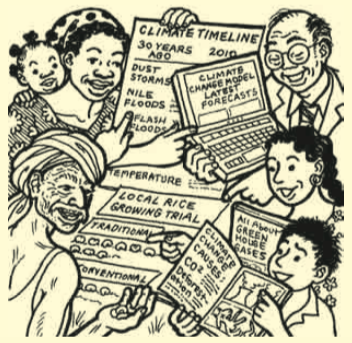Participatory learning and action special issue: Community-based adaptation to climate change

Introduction
It is now increasingly recognised that, for poor communities, adaptation approaches that are rooted in local knowledge and coping strategies, and in which communities are empowered to take their own decisions, are likely to be far more successful than top-down initiatives. In addition, communities have the right to participate in decisions that affect them. For these reasons, community-based adaptation has come to the fore in recent years.
‘Good’ community-based adaptation (CBA), like other forms of participatory development, is community-driven, empowering, and strengthens local capacity. Much CBA is rooted in disaster risk reduction approaches, designed to build the resilience of communities to disasters, such as floods and drought, with the difference that it should also incorporate longer-term climate change and its predicted impacts into community-based planning. Broader participatory community development and livelihood approaches should also be taking into account the effects of climate change, if development gains are to be sustained.
This special issue handbook is divided into three sections:
- The first section includes reflections on participatory processes and practice in community-based adaptation to climate change. These have a variety of entry points, including participatory vulnerability analysis, disaster risk reduction frameworks, and Farmer Field Schools. The case studies provide a rich source of experience and lessons for CBA practitioners.
- The second section focuses on participatory tool-based case studies. These describe a participatory process with an emphasis on the use of a particular participatory tool, such as participatory video or participatory mapping. They also reflect on the strengths and limitations of these tools.
- The third section, participatory tools, includes shorter, step-by-step descriptions of how to facilitate a particular tool in a community, for example, rain calendars and mental models of the drivers and effects of climate change.
The handbook can be downloaded from the right-hand column of this page or viewed online here.
In the handbook…
Theme section: Community-based adaptation to climate change
- Community-based adaptation to climate change: an overview by Hannah Reid, Mozaharul Alam, Rachel Berger, Terry Cannon, Saleemul Huq, and Angela Milligan
Part I: Reflections on participatory processes and practice
- Combining different knowledges: community-based climate change adaptation in small island developing states by Ilan Kelman, Jessica Mercer, and Jennifer J. West
- Children’s participation in community-based disaster risk reduction and adaptation to climate change by Thomas Tanner, Mercedes Garcia, Jimena Lazcano, Fatima Molina, Grace Molina, Gonzalo Rodriguez, Baltz Tribunalo, and Fran Seballos
- Katalysis: helping Andean farmers adapt to climate change by Stephen Sherwood and Jeffery Bentley
- Ethics and methods in research for community-based adaptation: reflections from rural Vanuatu by Olivia Warrick
- Participatory rice variety selection in Sri Lanka by Rachel Berger, with Rohana Weregoda and Varuna Rathnabharathie
- Lessons from a transboundary water governance project in West Africaby Sam Wong
Part II: participatory tool-based case studies
- Participatory three-dimensional mapping for disaster risk reduction by Jean-Christophe Gaillard and Emmanuel A. Maceda
- Amplifying children’s voices on climate change: the role of participatory video by Tamara Plush
- Farmers become filmmakers: climate change adaptation in Malawi by Fernanda Baumhardt, Ralph Lasage, Pablo Suarez, and Charles Chadza
Part III: Participatory Tools
- Developing a climate change analysis by Christian Aid
- Rain calendars: a tool for understanding changing rainfall patterns and effects on livelihoods by Cynthia Awuor and Anne Hammill
- Mental models: understanding the causes and consequences of climate change by Petra Tschakert and Regina Sagoe
- Child-friendly participatory research tools by Fatima Molina, Grace Molina, Tom Tanner, and Fran Seballos
- Participatory scenario development for translating impacts of climate change into adaptations by Livia Bizikova, Thea Dickinson, and László Pintér
- Reflections on practical ethics for participatory community-based adaptation extracts from Elkanah Absalom et al., and Giacomo Rambaldi et al
Tips for Trainers
- Communications maps by Sonal Zaveri
- Rivers of life by Ziad Moussa
Participatory Learning and Action (PLA) – formerly PLA Notes and RRA Notes – is published twice a year. Established in 1987, it enables practitioners of participatory methodologies from around the world to share their field experiences, conceptual reflections, and methodological innovations. The series is informal and seeks to publish frank accounts, address issues of practical and immediate value, encourage innovation, and act as a ‘voice from the field’.
We are grateful to the Swedish International Development Cooperation Agency (Sida) and the UK Department for International Development (DfID) for their continued financial support of PLA. The views expressed in this publication do not necessarily reflect the views of the funding organisations or the employers of the authors.
This special issue of PLA was produced in collaboration with IIED’s Climate Change Group. We would also like to acknowledge the support of the Bangladesh Centre for Advanced Studies (BCAS) and Practical Action for enabling the guest editors to provide their valuable input and expertise.
(1) Comment
Thank you for building this network of sharing knowledge.